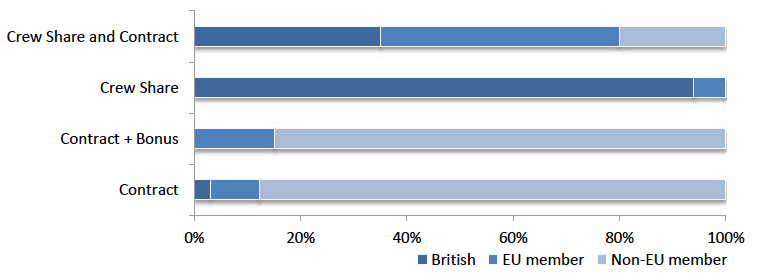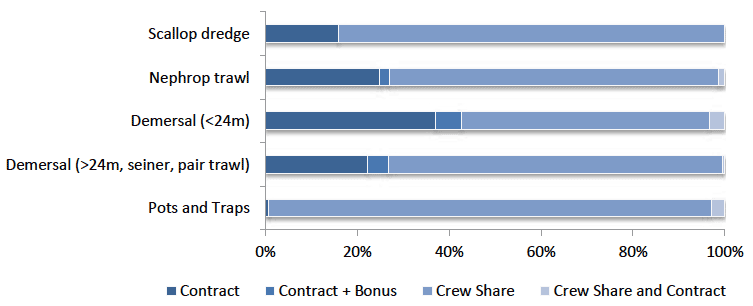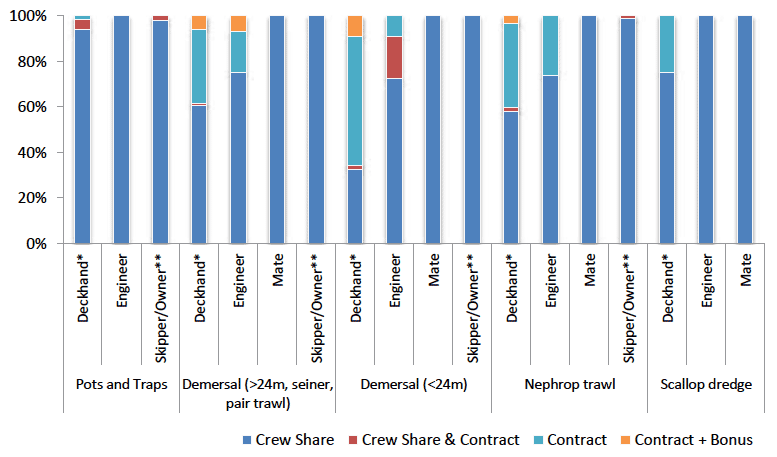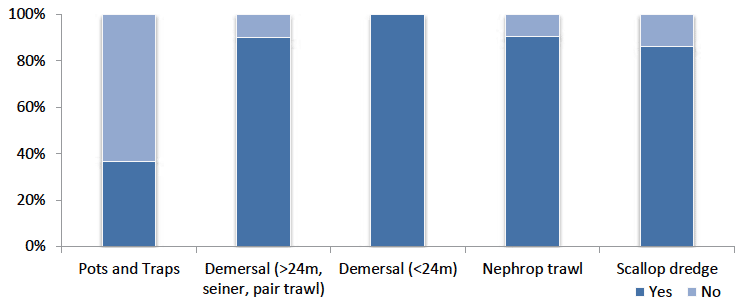Scottish Sea Fisheries Employment Report
This report details the findings of a new survey of crews on Scottish fishing vessels. It provides new information across a range of indicators such as age, nationality, job tenure and skills.
9. Remuneration
Crew share, which is the pay system whereby crews are paid a percentage of the vessel catch less costs, is still the most dominant type of remuneration agreement for British workers in the Scottish Fleet. EU workers have a range of remuneration agreements including crew share and contracts, some with bonuses. The majority of non- EU workers are on contracts with a small proportion also on bonuses or crew share in addition to their contracts (Fig. 27). By sector, pots and traps fishing is still dominated by crew share, whilst demersal (<24m) vessels have the highest proportion of crews on contracts and contracts with bonuses. Bonuses are more common on demersal vessels compared with other sectors (Fig. 28).
Figure 27: Types of remuneration agreements on vessels by British, EU and non- EU member nationalities ( n = 831)

Figure 28: Types of remuneration agreements by sector ( n = 812)

When data is presented by position and sector, it is deckhands and engineers that are on the more diverse contracts in both groups of demersal vessels and on Nephrops boats (Fig. 29). This is also the case for deckhands on scallop dredgers but to a lesser extent. In the demersal (<24m) vessels, two thirds (66%) of all deckhands are now on contracts. For deckhands on both Nephropss and on demersal (>24m, seiner and pair trawl) 40% and 38% respectively are on contracts. Engineers on demersal (<24m) vessels have relatively a high proportion of crew on crew share and contracts compared to other sectors.
Figure 29: Type of remuneration by position on vessel and key fishing sectors ( n = 810) *deckhands combined both cook/deckhands and deckhand **skipper/owner combines both skipper/owner and skippers ( n = 810).

Regarding whether food is included in crew's remuneration package, all crew on demersal <24M vessels had food whilst a small proportion in the three other mobile did not have food as part of their remuneration packages, with a slightly higher percentage for crews of scallop vessels (Fig. 30). For Pots and Traps only 36% had food included, mostly due to the nature of fishing operations with vessels mainly undertaking day trips.
Figure 30: Food included in remuneration ( n = 516)

Description of Remuneration per Sector
Pots and Traps: In almost all cases the fishing expenses (fuel, bait, other fishing costs) are taken out from the income from landings and of the remaining, 50% goes to the boat and 50% to the crew. If the vessel is a single-handed operation, the skipper/owner will take the full 50% or in some cases takes the full profits after the fishing expenses are paid. If crew are employed the vessel, often the 50% to the boats is standard and the 50% crew share is divided equally between the skipper/owner and crew or in some case the skipper/owner gets a higher percentage (e.g. 30%/20%). Crew share have been reported to drop to 10% of overall profits if boat maintenance is required. In some cases deckhands are salaried and given a small crew share as a bonus (seasonal work).
Demersal (<24m): As with the potting vessels in the majority of cases fishing expenses are taken out from the income from landings and of the remaining, 50%-70% goes to the boat and 30-50% to the crew. In this sector contracts are frequent which are described for non- EU crew as £1,200 per month with a bonus and return flight. For EU crew members the contracts range from £1,500-£1,800 per month in some cases with 2-3% crew share as a bonus. For skippers and engineers, shares range from 5-10% and for deckhands shares equalled 10%.
Demersal (>24m, seiners, and pair trawl): In all cases fishing expenses (fuel etc) are taken out from the income from landings and of the remaining 50%-60% goes to the boat and the remaining 40-50% to the crew. In this sector foreign crews are on a range of contracts and on a few vessels skippers and engineers are on set wages with bonus. In the case of skippers on crew share, percentage ranges from 10-25% and in some cases with a bonus. For engineers, shares range from 8-25% with higher bonus. In some vessels engineers are non- EU crew member and are on a fixed wages and bonus scheme. For deckhand crew share ranges from 10-25% with the majority on 16% and in a small number of cases bonuses are offered per box landed (around £1.50 box). As with other sectors, contracts for foreign workers are common and for EU crew wages are around £1000 with bonus (around £200 per month) and for non- EU wages equate to between £850-£1200 plus bonus.
Nephrops trawl: In almost all cases the fishing expenses (fuel etc) are taken out from the income from landings and of the remaining between 30-60% goes to the boat and remaining 40-70% to the crew. This sector is quite diverse. In some cases share is split equally between crews or if a single-handed vessel all goes to the skipper. In the case of skippers on crew share, percentage ranges from 7.5-25% or are described as a share + 2-3% bonus. For engineers, shares range from 7.5-10% with fixed bonus from £100-£250 a week or a share with percentage bonus of 1-2%. For deckhand crew share ranges from 4-10% with bonuses for local crews and contracts system for EU and non- EU crew. For EU crew wages are around £1800 and for non- EU wages equate to between £850-£1200 plus bonus. In the case of EU workers, some work one month on one month off and are paid for the months they work.
Scallop dredger: As above fishing expenses (fuel etc) are taken out from the income from landings and of the remaining between 40-50% goes to the boat and remaining 50-60% to the crew. In a couple of vessels owners take between 10-15%. For crew in many boats the crew share is equal across the position or, if not, the skipper takes 10-15%, engineers 5-10% and deckhands 5-12%. Much like above some foreign crews are on contracts which coincide with remuneration packages as described above.
Contact
There is a problem
Thanks for your feedback